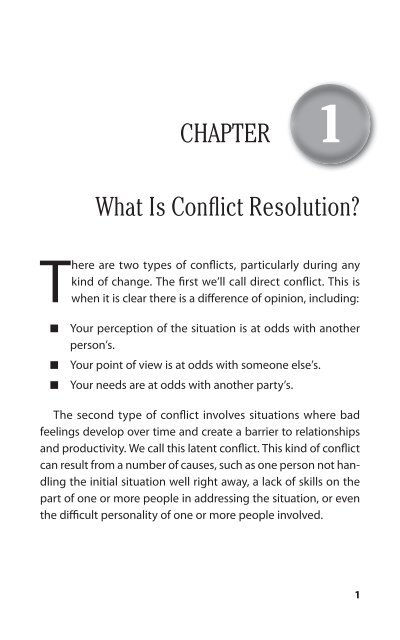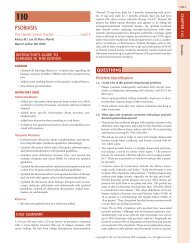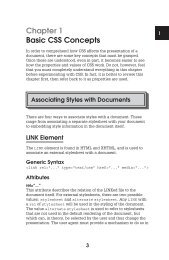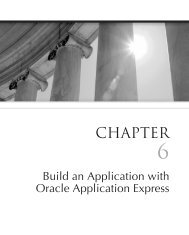CHAPTER What Is Conflict Resolution?
CHAPTER What Is Conflict Resolution?
CHAPTER What Is Conflict Resolution?
You also want an ePaper? Increase the reach of your titles
YUMPU automatically turns print PDFs into web optimized ePapers that Google loves.
<strong>CHAPTER</strong> 1<br />
<strong>What</strong> <strong>Is</strong> Confl ict <strong>Resolution</strong>?<br />
There are two types of confl icts, particularly during any<br />
kind of change. The fi rst we’ll call direct confl ict. This is<br />
when it is clear there is a diff erence of opinion, including:<br />
■ Your perception of the situation is at odds with another<br />
person’s.<br />
■ Your point of view is at odds with someone else’s.<br />
■ Your needs are at odds with another party’s.<br />
The second type of confl ict involves situations where bad<br />
feelings develop over time and create a barrier to relationships<br />
and productivity. We call this latent confl ict. This kind of confl ict<br />
can result from a number of causes, such as one person not handling<br />
the initial situation well right away, a lack of skills on the<br />
part of one or more people in addressing the situation, or even<br />
the diffi cult personality of one or more people involved.<br />
1
2 ➜ PERFECT PHRASES FOR CONFLICT RESOLUTION<br />
Why Do We Avoid Confl ict?<br />
At some point, everyone avoids confl icts at work, for reasons<br />
both good and bad. Think of a confl ict you are currently avoiding.<br />
Perhaps the confl ict has been lingering for a while, or maybe<br />
you think you can continue to do your work without resolving<br />
it. <strong>What</strong>ever the case, something about this particular confl ict is<br />
making you avoid getting it resolved. Some possible causes for<br />
avoiding resolution are that the confl ict is:<br />
■ Too risky. You believe there is too much political risk to<br />
address it. A poorly handled confl ict could result in fallout<br />
that will damage a project, a task, or even your career.<br />
■ Unpleasant. It is just hard.<br />
■ Too personal. You may think that the issue is not work<br />
related.<br />
■ Diffi cult to control. You do not have confi dence you can<br />
control yourself. Or maybe the other party has a history of<br />
being explosive and you think you don’t have the skills to<br />
manage the situation.<br />
And as you may have experienced yourself, the tendency to<br />
avoid confl ict is particularly high when dealing with latent confl<br />
icts. Direct confl icts easily burst into the open and require a<br />
solution, whether we like it or not.<br />
These reasons for avoidance are all real and valid, as are many<br />
others. This book will help you overcome these and other obstacles<br />
and fi nd an approach that will enable you to address confl ict<br />
productively and professionally.
Can Confl ict Be Resolved?<br />
WHAT IS CONFLICT RESOLUTION? ➜<br />
We have yet to run across an organization where all confl ict is<br />
resolved. Confl ict ebbs and fl ows in relationships in organizations.<br />
In fact, if we saw no confl ict during change in an organization<br />
(and as we all know they are continuously changing!), we<br />
would suspect the organization to be dying or already dead! The<br />
emotional exchange of ideas and perceptions is a natural part of<br />
people working together.<br />
Employees at all levels must continue working even when<br />
confl icts and ambiguities exist. Of course, there are some work<br />
confl ict situations that can be addressed through a short dialogue<br />
to clear up misunderstandings. Many others, however,<br />
take more work. They require more energy, a willingness to<br />
revisit the issue, and a personal commitment to working things<br />
out in the long term.<br />
If you are looking at resolution as all parties being completely<br />
happy with the outcome, then resolution is not attainable in<br />
most situations. Often, one person will be happy and another<br />
not. Partnerships may not be even; there may be a clear hierarchy<br />
between, for example, boss and subordinate or customer<br />
and supplier and the party in power just decides. Even if there<br />
is a more balanced partnership, it can take a lot of eff ort and<br />
time to create a “win/win.” We don’t always have the energy<br />
and time to approach it this way. Other times a confl ict—particularly<br />
latent confl icts—drags on, sometimes even a long time.<br />
We hope it dissipates by itself—and sometimes it does, either<br />
because the situation has changed (again), key players change,<br />
or it may just become less important due to new priorities or a<br />
diff erent mood (diff erent emotions) of the main parties.<br />
3
4 ➜ PERFECT PHRASES FOR CONFLICT RESOLUTION<br />
Rules of Engagement<br />
<strong>What</strong> does it take to successfully resolve confl ict?<br />
1. Confl ict <strong>Resolution</strong> <strong>Is</strong> Not for the Faint of Heart<br />
As a fi rst step in approaching confl ict resolution, look honestly<br />
at yourself to see whether you have what it takes to address confl<br />
ict. Attributes of a good confl ict handler include:<br />
■ Courage. Confl ict always involves potential misinterpretation<br />
and hurt feelings. It takes courage to walk calmly and deliberately<br />
through the ambiguity and try to resolve it.<br />
■ Balancing your interests with the interests of others. Ultimately,<br />
you must care about the other person and her or her<br />
point of view to resolve confl ict. If you focus too much on yourself,<br />
you are being infl exible. Too much focus on the other party,<br />
on the other hand, means you overlook your own needs. It takes<br />
a balanced view.<br />
■ Thinking on your feet. Being prepared is important. However,<br />
don’t expect to have your conflict resolution plan all<br />
worked out and be able to stick with it. Humans are unpredictable,<br />
even the ones we know the best, so plan on adjusting your<br />
plan.<br />
■ Letting go of the “resolution.” To be eff ective in confl ict,<br />
one must adopt the mind-set of living in the state of ambiguity.<br />
Many times, you will have to live with an ongoing subtext of<br />
disagreement until sometime in the future when the issue may<br />
be resolved. Then again, it may never be resolved, or it may be
WHAT IS CONFLICT RESOLUTION? ➜<br />
resolved to the satisfaction of the other person but not you. The<br />
bottom line is that you must accept that confl ict will always exist,<br />
while a completely satisfying resolution may not.<br />
2. Know When to Give in and When to Hold<br />
Your Ground<br />
A simple way to avoid unnecessary confl ict and to only fi ght for<br />
your point of view when necessary is to think about how much<br />
interest you have in the outcome of a particular confl ict compared<br />
to how much interest the other party has. Using these two<br />
dimensions, you can easily decide how to approach the confl ict:<br />
■ Low interest to you, low interest to the other party:<br />
Forget it. This is not worth debating.<br />
■ Low interest to you, high interest to the other party:<br />
Give in. Why turn it into a fi ght if you don’t really care<br />
about it?<br />
■ High interest to you, low interest to the other party:<br />
Advocate. In situations where the outcome aff ects you<br />
more than the other person or people, be strong and<br />
advocate your position.<br />
■ High interest to you, high interest to the other party:<br />
Collaborate. The only way to come up with a productive<br />
solution is for both parties to work together. These are<br />
also the situations that can become the most contentious<br />
because both parties care so much about the results.<br />
5
6 ➜ PERFECT PHRASES FOR CONFLICT RESOLUTION<br />
3. Balance Cooperation and Advocacy<br />
The central art of handling confl ict is balancing being cooperative<br />
while at the same time advocating for your point of view.<br />
How direct should you be? If you are too passive, you will focus<br />
too much on making the other party happy at your expense or<br />
at the expense of the business issue. If you are too aggressive,<br />
you wind up focusing more on getting your way than on the<br />
other party’s feelings and point of view. When you are aggressive,<br />
you might also be blaming the other person for the problem.<br />
The challenge is to fi nd the middle ground: being assertive.<br />
This means to encourage and support the other person’s openness<br />
while advocating your point of view. It means taking both<br />
your and the other person’s thoughts, feelings, and wants into<br />
account.<br />
These phrases will help you know which part of the spectrum<br />
you are on:<br />
Passive<br />
■ <strong>What</strong>ever you do is OK with me.<br />
■ It doesn’t matter.<br />
■ <strong>What</strong>ever.<br />
■<br />
Aggressive<br />
You always .<br />
■ You never .<br />
■ <strong>What</strong> is the matter with you?
Assertive<br />
WHAT IS CONFLICT RESOLUTION? ➜<br />
■ I hear you saying that . However, what I<br />
want/need is . The reason(s) I need this is/<br />
are . Does that make sense? Let’s see if we<br />
can come up with a mutually workable solution.<br />
■ I understand that you are having a problem with<br />
. I would like to make a request. The next<br />
time this happens, could we ?<br />
■ This doesn’t seem to be working for either of us. It is not<br />
working for me because . <strong>What</strong> would work<br />
better for me is . Would that work for you?<br />
4. Be Direct and Avoid Triangulation<br />
Talk to the person with whom you have the confl ict. While you<br />
may decide to speak to someone who is not involved for advice<br />
on how to handle a situation, asking that person to take sides or<br />
intervene on your behalf only creates more interpersonal problems.<br />
Such an action erodes trust and reduces the chance of<br />
future issues being resolved. (See the section on cultural aspects<br />
later in this chapter for further discussion.)<br />
5. Reduce Static<br />
<strong>What</strong> we call static is anything within a person or an environment<br />
that interferes with clear communication. It is the same<br />
concept as the static on the radio when you try to tune in to a<br />
station and can’t get good reception. The resulting noise is a<br />
distraction from the song you want to hear.<br />
7
8 ➜ PERFECT PHRASES FOR CONFLICT RESOLUTION<br />
Static can be in our environment as well as in our head. Some<br />
common examples of static are:<br />
■ Background noise<br />
■ Physical distractions—pain, hunger, or fatigue<br />
■ Jumping to solutions—moving too quickly to solve an<br />
issue, without considering the whole situation, can cause<br />
disruption<br />
■ Asking too many questions—if you are asking questions<br />
all the time and interrupting the talker, you may be overtaking<br />
the conversation<br />
■ Interruptions—other people, walking in from outside, can<br />
be static. Find out what they are looking for. <strong>Is</strong> it an emergency?<br />
Do they want advice? Do they just want someone<br />
to talk to? Depending on the situation, you should ask for<br />
a meeting at a more appropriate time.<br />
■ Your own mind—you can think much faster than you<br />
can speak! Your mind has extra bandwidth and naturally<br />
wanders away. So what can you do to help with that extra<br />
bandwidth? Make your conversation more interactive.<br />
Pause. Ask for your listener’s input. Check whether he or<br />
she has any questions.<br />
When discussing contentious issues, set up a time and place<br />
when you and your colleague can give the discussion your full<br />
attention. This will let both of you focus your mind and energy<br />
on the conversation.
Phases of Confl ict<br />
WHAT IS CONFLICT RESOLUTION? ➜<br />
All of the phrases in this book follow a four-step process to handle<br />
confl ict:<br />
1. Understand the issue<br />
2. Set a vision<br />
3. Explore alternatives<br />
4. Agree on action<br />
Following this simple structure increases your success in confl ict<br />
situations. With that said, it is hard to always follow it perfectly.<br />
It is meant as a guideline to address the key aspects of confl ict<br />
situations.<br />
Each of these four steps is further outlined below:<br />
Understand the <strong>Is</strong>sue<br />
Framing the beginning of the conversation as an opportunity<br />
to understand the issue, rather than as a fi ght or argument, will<br />
make it easier to begin the resolution process. Here are the key<br />
elements of this step:<br />
■ Ask for a meeting: Before speaking with the person with<br />
whom you have a confl ict, ask for a meeting. It is always best<br />
if you and your colleague can focus on the issue without being<br />
disturbed. You may also want to prepare so you can handle the<br />
meeting eff ectively.<br />
9
10 ➜ PERFECT PHRASES FOR CONFLICT RESOLUTION<br />
You may not want to disclose any of the details of the topic<br />
of conversation in an e-mail or a phone call when setting up a<br />
meeting. Once you bring up the issue, the conversation starts.<br />
If both of you are not in a place or space to fully discuss it, the<br />
conversation can backfi re because neither of you can do justice<br />
to the complexity and emotions of the topic.<br />
Instead, try saying something like “I would like to meet with<br />
you to discuss an important issue.” If the other person asks you<br />
what that topic is, it is better to say something along the lines<br />
of “It would be best to discuss it when we can both focus on it.”<br />
This communicates that the topic is not quick, that it is important,<br />
and that it could be complicated and emotional, which<br />
helps ensure he or she sets up a time and place for such a conversation.<br />
In addition, he or she will be curious and come ready<br />
to listen.<br />
Here is an example:<br />
Employee: “Mary, I’d like to schedule a meeting with you to<br />
discuss an important issue.”<br />
Boss: “<strong>What</strong> is it?”<br />
Employee: “I’d rather talk about it when we both have time<br />
to talk with our full attention. When would you have thirty<br />
minutes?”<br />
Boss: “I need to know what it is so I can prepare.”<br />
Employee: “I understand that. However, if I open the conversation<br />
now it will just complicate things. Are you willing to trust<br />
me and we can take all the time we need at the meeting?”<br />
When the meeting begins, you will need to raise the issue.<br />
You will notice in our phrases we begin with raising the issue, the<br />
fi rst part of any confl ict resolution, which is often the hardest.
WHAT IS CONFLICT RESOLUTION? ➜<br />
■ Open discussion: It helps to fi nd a neutral or positive way to<br />
open the discussion such as talking about other things, business<br />
or personal.<br />
■ Share specifi cs: Make sure that you come to the discussion<br />
prepared. Have specifi c examples and cases in mind so you can<br />
help make the conversation concrete and prevent it from escalating<br />
into blaming and accusations.<br />
Raise the issue by being as specifi c as possible. Mention the<br />
specifi c situation(s) or events(s) that upset you. If you can identify<br />
behaviors, such as what the other person did or did not say or<br />
do, that is particularly helpful. This will help focus the conversation<br />
rather than the other person perceiving you as attacking<br />
him or her.<br />
■ Discuss impact: If possible, explain the impact the event<br />
had on you, the team, other people, the business, or customers.<br />
Again, this will help the other person understand that you are<br />
not raising this issue just to be diffi cult.<br />
■ Listen: A key part of understanding the issue is to understand<br />
the other person’s point of view. Ask questions. Be curious. Follow<br />
the guidelines later in this chapter on listening. This will go<br />
a long way toward building understanding and ultimately to<br />
resolving the confl ict.<br />
Set a Vision<br />
Before you decide to address a confl ict, you need to be very clear<br />
about what your objectives are in addressing it. Do you want to:<br />
■ Improve a relationship?<br />
■ Resolve a business issue?<br />
11
12 ➜ PERFECT PHRASES FOR CONFLICT RESOLUTION<br />
■ Assure better service quality or deliver best customer<br />
service?<br />
■ Promote yourself?<br />
■ Make future life at work easier?<br />
■ Get compliance with the process you are in charge of?<br />
Articulating a vision for the future, after you have explored<br />
the issue, will help both parties move beyond the past and into<br />
a more positive frame of mind.<br />
Explore Alternatives<br />
Once the vision is out on the table, both parties can openly<br />
discuss how to get there. The phrases at this stage are either<br />
questions to get the other person’s ideas on how to rectify the<br />
situation or your suggestions on how to do the same:<br />
■ How are you going to do it?<br />
■ How can I help?<br />
■ <strong>What</strong> ideas do you have to prevent this in the future?<br />
■ <strong>What</strong> could you do to make sure this doesn’t happen<br />
again?<br />
■ I’ll need a little time to process this before we talk some<br />
more.<br />
■ In the future could you include me on<br />
taking action?<br />
before<br />
■ For the next project, let’s meet when we start and clearly<br />
defi ne roles, responsibilities, and decision- making process.
WHAT IS CONFLICT RESOLUTION? ➜<br />
■ I might need to talk to if we cannot work this<br />
out.<br />
Use these types of questions or suggestions—or both—as your<br />
situation warrants.<br />
Agree on Action<br />
If you get this far, you are likely to get to agreement. The only<br />
exception would be if the two of you cannot agree on how to fi x<br />
the problem. If that is the case, you may want to ask for a chance<br />
to think it over and meet again. Or you may need to inform him<br />
or her of your intention to escalate the issue. <strong>What</strong>ever the case,<br />
make sure to end with being clear about who is going to do<br />
what.<br />
Handling Emotions<br />
The facts or fi gures are often not the problem in confl ict; the<br />
emotions are. Depending on the personalities, situations,<br />
power-diff erentials, and skills of each party, confl ict creates a<br />
wide range of personal emotional reactions.<br />
Take the situation of a diff erence of opinion with your manager<br />
about your performance. The facts may be unclear as to<br />
whether you have met your manager’s expectations. Expectations<br />
are subjective and may not have been outlined specifi -<br />
cally. In addition, your manager has more organizational power<br />
than you. Especially if it is a situation where money and career<br />
advancement are at stake, the emotions can begin to ratchet up.<br />
Fear, anxiety, and stress can build and create a barrier to<br />
clear communication. Blaming, avoidance, and/or arguing often<br />
13
14 ➜ PERFECT PHRASES FOR CONFLICT RESOLUTION<br />
ensue. The approaches in this book are meant to reduce emotions<br />
and create clarity and understanding.<br />
Strategies for Handling Negative Emotions<br />
There are several approaches you can use to reduce the negative<br />
emotions in yourself and others during confl ict. The following<br />
are some ideas and phrases you can use:<br />
■ Sit at the same side of the table. This reduces the psychological<br />
barrier of the table and opens up the communication.<br />
■ Delay: “Let’s talk about it later when we have more time to<br />
think it through.”<br />
■ Lower expectations: “I know you won’t like this but I think<br />
we need to talk about it anyway.”<br />
■ Start with the positive: “You are very good at<br />
however, .”<br />
■ Break the tension by being relaxed and personal: “I am so<br />
glad we are talking about this.” “You are really someone I<br />
trust to work this through with.”<br />
■ Include commonalities and points of agreements as you’re<br />
discussing the diff erences: “You are right we do need to<br />
work on . It is also getting clear from this conversation<br />
that we are doing pretty well with .”<br />
■ Acknowledge the other person’s diffi culty: “I see that this<br />
is a challenge for you.” “I hear that you are having a hard<br />
time with .”<br />
■ Take responsibility for your part in the problem: “I see now<br />
how I am contributing to this by doing .”
WHAT IS CONFLICT RESOLUTION? ➜<br />
■ Take responsibility for solving the problem: “Next time<br />
I .”<br />
■ Apologize, if necessary: “I am so sorry I create this problem.”<br />
“I apologize for inadvertently creating such reactions.”<br />
Counterproductive Confl ict Beliefs<br />
<strong>What</strong> comes fi rst, thoughts or feelings? The research on emotional<br />
intelligence shows that thoughts come fi rst. Imagine how<br />
it feels when someone you don’t like walks into your offi ce; you<br />
have a feeling of dread or stress. If you track back to what you<br />
were thinking when he or she walked in, you will realize that<br />
you had a negative thought, such as “Oh no,” or “I don’t want<br />
to deal with this right now.”<br />
Our thoughts can be our own worst enemy during confl ict.<br />
Some thoughts/beliefs that we have found to interfere with<br />
resolving confl ict include:<br />
■ ”It may resolve itself”—this creates a delay in resolving the<br />
issue and may even build a bigger problem.<br />
■ ”It is not important enough”—this thought minimizes the<br />
person and the issue, which may come back to haunt you.<br />
■ ”He or she will never understand”—this becomes a selffulfi<br />
lling prophecy.<br />
■ ”It is useless”—this is another self-fulfi lling prophecy.<br />
■ ”It’s not me, it is my boss’s job to handle this”—this puts<br />
the responsibility on someone else’s shoulders.<br />
■ ”We can’t have that conversation here”—having that conversation<br />
is just plain hard work and no one wants to do it.<br />
15
16 ➜ PERFECT PHRASES FOR CONFLICT RESOLUTION<br />
Listening<br />
Part of the frustration in any confl ict comes from feeling like the<br />
other person doesn’t understand. He or she is not listening.<br />
Lack of listening by either side escalates confl ict. Before you<br />
tell the other person you disagree or make your point yet again,<br />
try listening to him or her. Even a small bit of listening will go a<br />
long way to increase understanding and reduce confl ict.<br />
Should you think listening is for those who are not strong<br />
enough to take charge, take a cue from Jim Higgins, a former<br />
police offi cer. Jim worked for thirteen years in enforcement<br />
on the streets in New York, dealing with drug dealers, prostitutes,<br />
gambling, and domestic disputes across cultures and<br />
neighborhoods.<br />
We had the privilege of interviewing him about the secret to<br />
eff ective policing and de-escalating confl ict. <strong>Is</strong> it force? <strong>Is</strong> it psychology?<br />
<strong>Is</strong> it fear?<br />
Surprisingly, Jim said that none of those were the answer.<br />
Whether dealing with an angry tenant or a psychotic claiming<br />
his mother is a Russian spy, he says the secret is to “Listen. Mirror<br />
what people are saying. Try from the beginning to be understanding<br />
and kind. It calms people down. Once you start to act<br />
like a tough guy, you can’t go back and be understanding—it<br />
is too late.”<br />
So how can you do this?<br />
First, focus on the other person. In today’s busy world of a<br />
hundred e-mails a day, multiple work projects, and constant<br />
pressure, everyone is stressed. Help yourself focus by looking<br />
at the other person, taking notes about the conversation, turn-
WHAT IS CONFLICT RESOLUTION? ➜<br />
ing away from the computer, shutting off the monitor, closing<br />
e-mail. Focus your attention on him or her, not on yourself.<br />
Remember that there are always multiple levels of communication<br />
going on—the actual words, the tone of voice, and body<br />
language. Words are easiest, but even then you can be misled.<br />
Voice tone is not so much up for interpretation, but it is still<br />
important. For example, “Yeah, right” said in an agreeable tone is<br />
far diff erent than “Yeah, right” said in a sarcastic tone. The words<br />
are the same, but the change of tone makes a big diff erence.<br />
The same is true for many body postures, which can have<br />
multiple meanings. A good thing to keep in mind is the change<br />
of a body posture. For example, if we are talking and, in the middle<br />
of the conversation, I cross my arms, that posture change<br />
means something has probably changed in my perception of<br />
the conversation.<br />
Most important, explore the other person’s point of view.<br />
<strong>What</strong> is he or she talking about? Why are his or her beliefs what<br />
they are? Ask sincere questions to gain understanding so that<br />
you will be able to:<br />
■ Get more information on his or her point of view<br />
■ Communicate you care about how he or she sees things<br />
■ Move from the emotion-laden part of your brain to the<br />
rational side<br />
By asking questions, you can explore his or her point of view:<br />
■ Why do you think that?<br />
■ <strong>What</strong> makes you feel that way?<br />
17
18 ➜ PERFECT PHRASES FOR CONFLICT RESOLUTION<br />
■ <strong>What</strong> happened to give you that impression?<br />
■ <strong>What</strong> did I say that led you to that conclusion?<br />
You can also paraphrase what you heard to make sure you<br />
understand the other person’s point of view correctly. Such<br />
phrases as the following will help you mirror his or her words<br />
well:<br />
■ It sounds like you are saying . . .<br />
■ Do you mean . . .<br />
■ Let me make sure I understand you. You said . . .<br />
Culture and Confl ict<br />
Do you work in a culture in which people address confl icts or<br />
one in which people avoid confl icts? How do you know?<br />
For starters, consider your meetings. Are they animated,<br />
engaged, full of constructive dialogue? Do they include confl icting<br />
point of views and discussions about them? In this case, you<br />
may be in a culture that is open to confl ict.<br />
If your meetings are boring and usually just include the presentation<br />
facts, it may mean that the participants of the meeting<br />
have little in common and no overlapping responsibilities;<br />
however, often it is an indication for confl ict avoidance. Confl ictavoidance<br />
cultures have destroyed more value than any other<br />
single business behavior! Look at it this way: To have a healthy<br />
discourse and discuss new and opposing ideas is a key ingredient<br />
to innovation, business process improvements, and personal<br />
development. On the other side, if you don’t dare to bring up
WHAT IS CONFLICT RESOLUTION? ➜<br />
thought-provoking ideas, voice concern, or break with “common<br />
wisdom,” you, your department, and your company will<br />
continue to dwell in the “same old, same old.” Problems may be<br />
ignored until they blow up with a big bang. Often it is too late<br />
by then.<br />
<strong>Is</strong>sues of Power<br />
Managing conflict is difficult. When you add in important<br />
aspects of diversity, such as race, gender, sexual orientation, age,<br />
and culture, it can get even more complicated.<br />
When two people have many similarities, even if the confl ict<br />
is strong, there is a good possibility of resolving the confl ict successfully.<br />
The more diff erences there are between the two parties,<br />
the more complicated resolution gets.<br />
Amounts of organizational power are based on the groups<br />
people belong to. A simple example is level in the hierarchy. You<br />
have likely been supervised by someone and know how careful<br />
you need to be when diff erences of opinions or strong feelings<br />
occur. You might even have had the experience of not raising an<br />
important issue due to a concern that your manager wouldn’t<br />
understand you or would even punish you in some way for raising<br />
the issue. This is because your boss has more power than<br />
you.<br />
This may also be the case if you are from a diff erent culture or<br />
ethnic group or even sexual orientation than most people in the<br />
organization. When engaging the confl ict, you might not want<br />
to “rock the boat,” especially if you are trying to fi t in to a group<br />
while being the only person like yourself.<br />
19
20 ➜ PERFECT PHRASES FOR CONFLICT RESOLUTION<br />
How Do We Reduce Power Differences?<br />
Many executives report they wish they would get more pushback<br />
from their staff . They would like to be challenged and<br />
disagreed with. They purport to have “open door policies” and<br />
believe they are creating open climates where disagreements<br />
can be aired freely. Yet very few staff take them up on the off er.<br />
These leaders are either unaware of or unable to change the<br />
dynamic.<br />
Having power can be blinding. Thus the challenge in managing<br />
confl ict across diff erences is most signifi cant when you<br />
are in the more dominant powerful position. The more power<br />
you have (vis-à-vis group memberships), the more you need to<br />
exhibit the following behaviors:<br />
■ Be aware of power diff erences. In any confl ict situation, look<br />
at the group membership diff erences in the people involved.<br />
Consider race, culture, gender, age, sexual orientation, organizational<br />
level, and any other diff erence that has resonance within<br />
the organization. Might they be hesitant to speak up or to give<br />
in? Might they feel superior and listen less? For example, women<br />
may have to walk a fi ne line when presenting a diff erent opinion—they<br />
could be concerned about being perceived as not a<br />
team player or as too pushy. Men can be blunt and direct; while<br />
such behavior might be uncomfortable, it would be perceived as<br />
being “really upset” or regarding something “really important”<br />
rather than being pushy.<br />
■ Consider the impact of bias. Ask yourself what biases you<br />
might hold that will aff ect your behavior. For example, is it OK<br />
when a man pushes back but not when a woman does? Do you
WHAT IS CONFLICT RESOLUTION? ➜<br />
expect your employees to follow what you say just because you<br />
are the boss? Then consider how these biases might impact the<br />
outcome of the confl ict.<br />
■ Work hard to build relationships. Build relationships across<br />
diff erences by being genuinely interested in people who are different<br />
from you. Seek them out and inquire about their lives,<br />
perspectives, and experiences. Take extra time to explore their<br />
point of view. Building strong relationships will make it easier to<br />
discuss tough issues when they come up.<br />
21

















